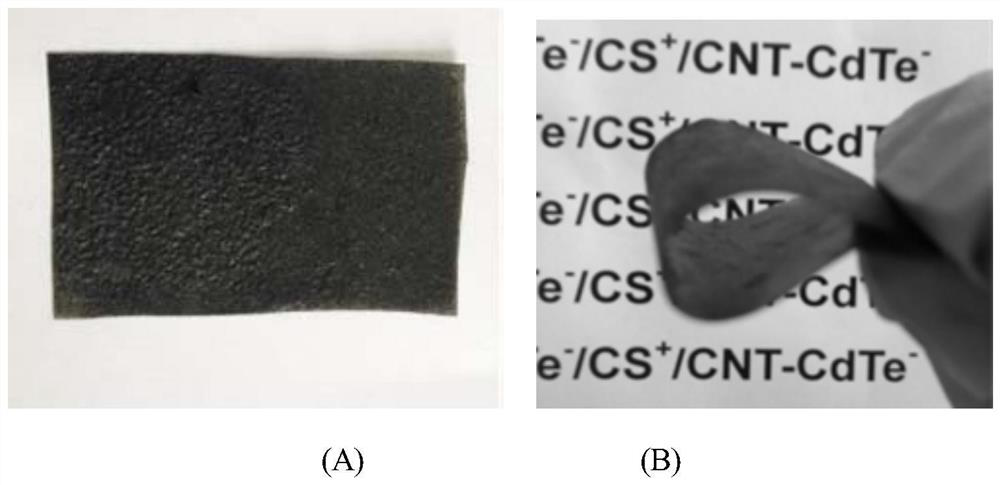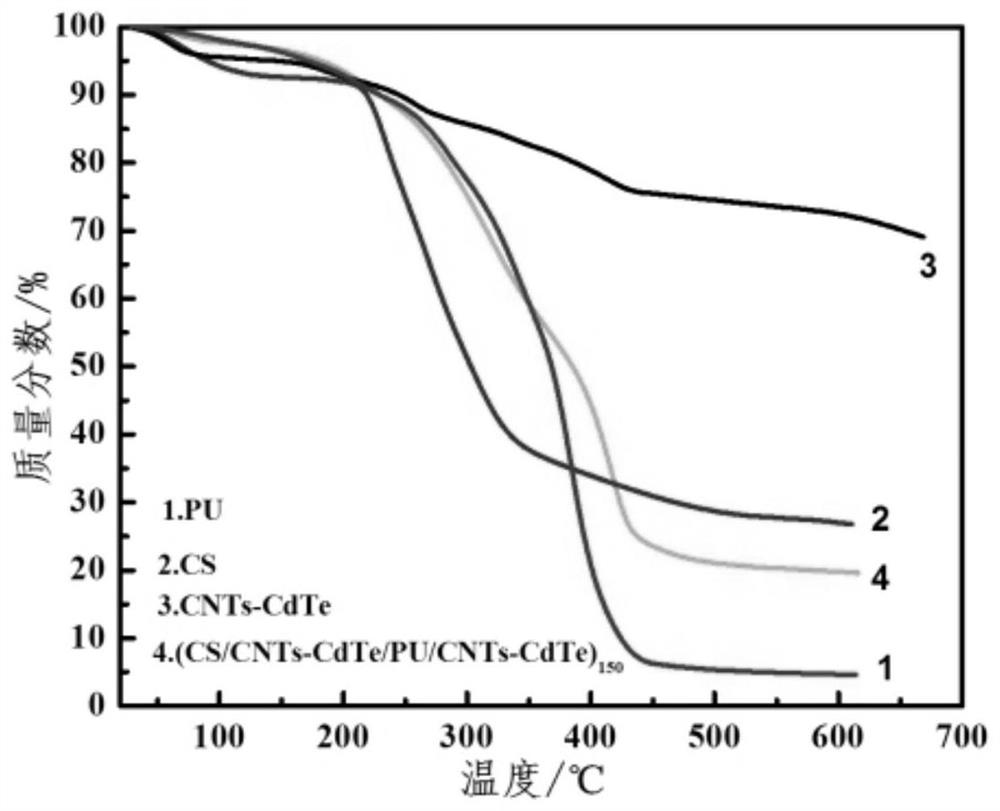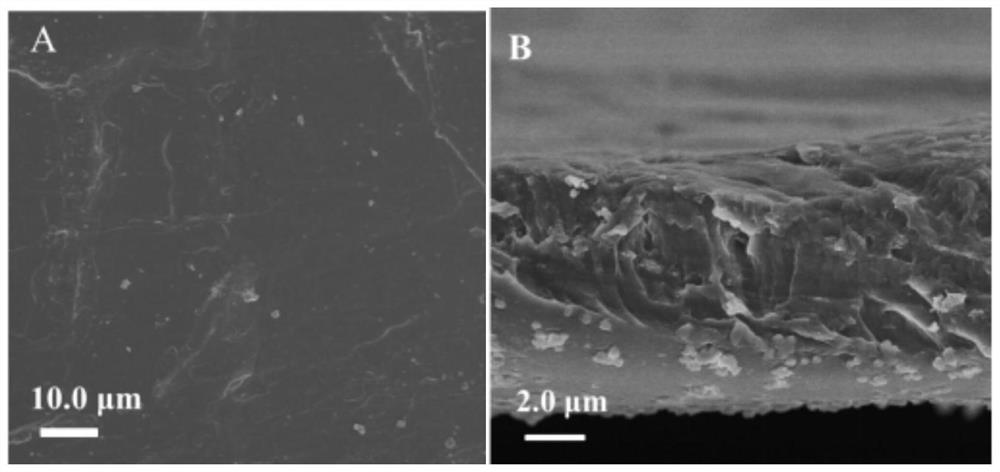Method for preparing high-temperature proton exchange membranes based on three-component layer-by-layer self-assembly technology
A technology of layer-by-layer self-assembly and proton exchange membrane, which is applied in the direction of final product manufacturing, sustainable manufacturing/processing, climate sustainability, etc., can solve the problem of single and limited performance adjustable components, and achieve improved proton conductance efficiency, accelerated conduction, and good thermal stability
- Summary
- Abstract
- Description
- Claims
- Application Information
AI Technical Summary
Problems solved by technology
Method used
Image
Examples
Embodiment 1
[0030] (1) Add 0.3g of carbon nanotubes (CNTs) into 30mL of CdTe nanocrystal aqueous solution, magnetically stir for 2 hours, and prepare a (CNTs-CdTe) aqueous solution with a mass fraction of 3wt%; wherein, the CdTe nanocrystal Cd The / Te atomic ratio is 5:1, and the concentration of CdTe nanocrystal aqueous solution is 0.879g / L.
[0031] (2) use piranha (piranha) solution (mass fraction 98wt%H 2 SO 4 Aqueous solution: mass fraction 30% H 2 o 2 The mass ratio of the aqueous solution is 7:3), and the negatively charged glass sheet on the surface treated is immersed in a polyurethane (PU) aqueous solution with a mass fraction of 3 wt%, and soaked for 6 minutes;
[0032] (3) Take out the glass sheet, soak it in deionized water for 20 seconds, take it out and blow it until the surface is dry, and soak it in the (CNTs-CdTe) aqueous solution with a mass fraction of 3 wt% prepared in step (1) for 6 minutes;
[0033] (4) Take out the glass sheet, after soaking in deionized water ...
Embodiment 2
[0039] (1) Add 0.3g of carbon nanotubes (CNTs) into 30mL of CdTe nanocrystal aqueous solution, magnetically stir for 2 hours, and prepare a (CNTs-CdTe) aqueous solution with a mass fraction of 3wt%; wherein, the CdTe nanocrystal Cd The / Te atomic ratio is 5:1, and the concentration of CdTe nanocrystal aqueous solution is 0.879g / L.
[0040] (2) use piranha (piranha) solution (mass fraction 98wt%H 2 SO 4 Aqueous solution: mass fraction 30wt% H 2 o 2 The mass ratio of the aqueous solution is 7:3), and the negatively charged glass sheet on the treated surface is immersed in a polyurethane (PU) aqueous solution with a mass fraction of 3 wt%, and soaked for 10 minutes;
[0041] (3) Take out the glass sheet, soak it in deionized water for 20 seconds, take it out and blow it to the surface without water, and soak it in the (CNTs-CdTe) aqueous solution with a mass fraction of 3 wt% prepared in step (1) for 10 minutes;
[0042] (4) Take out the glass flakes, after soaking in deioniz...
Embodiment 3
[0048] (1) Add 0.3g of carbon nanotubes (CNTs) into 30mL of CdTe nanocrystal aqueous solution, magnetically stir for 2 hours, and prepare a (CNTs-CdTe) aqueous solution with a mass fraction of 3wt%; wherein, the CdTe nanocrystal Cd The / Te atomic ratio is 5:1, and the concentration of CdTe nanocrystal aqueous solution is 0.879g / L.
[0049] (2) use piranha (piranha) solution (mass fraction 98wt%H 2 SO 4 Aqueous solution: mass fraction 30wt% H 2 o 2 The mass ratio of the aqueous solution is 7:3), and the negatively charged glass sheet on the treated surface is immersed in a polyurethane (PU) aqueous solution with a mass fraction of 5 wt%, and soaked for 8 minutes;
[0050] (3) Take out the glass sheet, soak it in deionized water for 20 seconds, take it out and blow it until the surface is dry, and soak it in the (CNTs-CdTe) aqueous solution with a mass fraction of 3wt% prepared in step (1) for 8 minutes;
[0051] (4) Take out the glass sheet, after soaking in deionized water...
PUM
| Property | Measurement | Unit |
|---|---|---|
| thickness | aaaaa | aaaaa |
| thickness | aaaaa | aaaaa |
| thickness | aaaaa | aaaaa |
Abstract
Description
Claims
Application Information
 Login to View More
Login to View More - R&D
- Intellectual Property
- Life Sciences
- Materials
- Tech Scout
- Unparalleled Data Quality
- Higher Quality Content
- 60% Fewer Hallucinations
Browse by: Latest US Patents, China's latest patents, Technical Efficacy Thesaurus, Application Domain, Technology Topic, Popular Technical Reports.
© 2025 PatSnap. All rights reserved.Legal|Privacy policy|Modern Slavery Act Transparency Statement|Sitemap|About US| Contact US: help@patsnap.com



